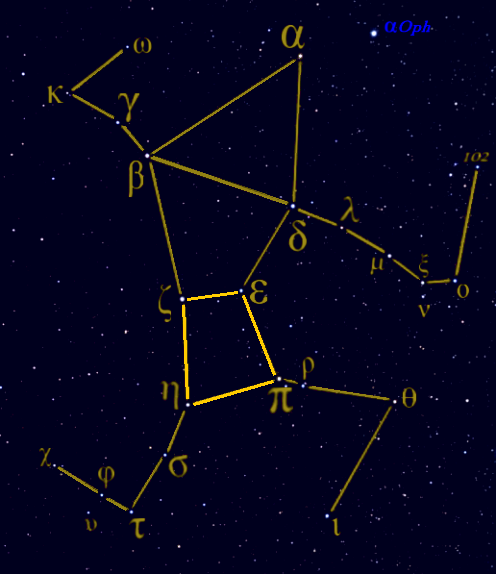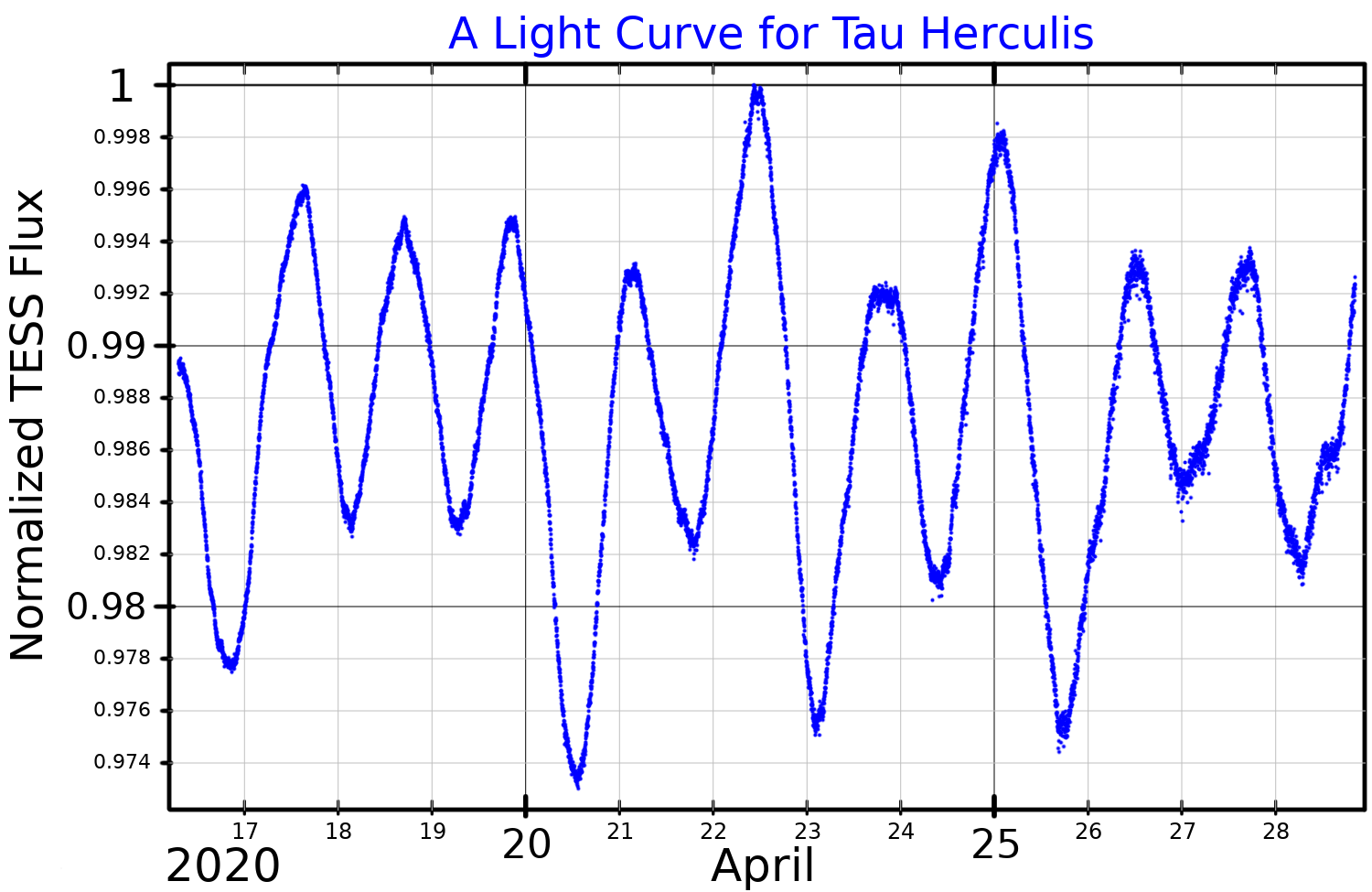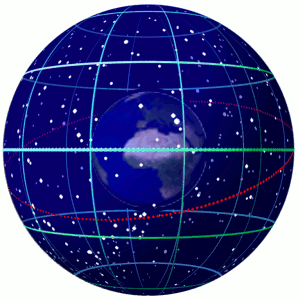|
Iota Herculis
Iota Herculis (ι Herculis, ι Her) is a fourth-magnitude variable star system in the constellation Hercules, consisting of at least four stars all about away. The brightest is a β Cephei variable, a pulsating star. Visibility Iota Herculis is dim enough that in cities with a lot of light pollution it is unlikely to be visible with the naked eye. In rural areas it will usually be visible, and for much of the Northern Hemisphere the star is circumpolar and visible year around. Pole star As a visible star, the proximity of Iota Herculis to the precessional path the Earth's North Pole traces across the celestial sphere makes it a pole star, a title currently held by Polaris. In 10,000 BCE it was the pole star, and in the future it will be again. While Polaris is only 0.5° off the precessional path Iota Herculis is 4° off. Properties Iota Herculis is a B-type subgiant star that is at the end of its hydrogen fusion stage. With a stellar classification B3IV, ... [...More Info...] [...Related Items...] OR: [Wikipedia] [Google] [Baidu] |
Hercules Historical View
Hercules (, ) is the Roman equivalent of the Greek divine hero Heracles, son of Jupiter and the mortal Alcmena. In classical mythology, Hercules is famous for his strength and for his numerous far-ranging adventures. The Romans adapted the Greek hero's iconography and myths for their literature and art under the name ''Hercules''. In later Western art and literature and in popular culture, ''Hercules'' is more commonly used than ''Heracles'' as the name of the hero. Hercules is a multifaceted figure with contradictory characteristics, which enabled later artists and writers to pick and choose how to represent him. This article provides an introduction to representations of Hercules in the later tradition. Mythology Birth and early life In Roman mythology, although Hercules was seen as the champion of the weak and a great protector, his personal problems started at birth. Juno sent two witches to prevent the birth, but they were tricked by one of Alcmene's servants a ... [...More Info...] [...Related Items...] OR: [Wikipedia] [Google] [Baidu] |
Light Pollution
Light pollution is the presence of unwanted, inappropriate, or excessive use of artificial lighting. In a descriptive sense, the term ''light pollution'' refers to the effects of any poorly implemented lighting, during the day or night. Light pollution can be understood not only as a phenomenon resulting from a specific source or kind of pollution, but also as a contributor to the wider, collective impact of various sources of pollution. Although this type of pollution can exist throughout the day, its effects are magnified during the night with the contrast of darkness. It has been estimated that 83 percent of the world's people live under light-polluted skies and that 23 percent of the world's land area is affected by skyglow. The area affected by artificial illumination continues to increase. A major side-effect of urbanization, light pollution is blamed for compromising health, disrupting ecosystems, and spoiling aesthetic environments. Globally, it has increased by at least ... [...More Info...] [...Related Items...] OR: [Wikipedia] [Google] [Baidu] |
Stellar Classification
In astronomy, stellar classification is the classification of stars based on their spectral characteristics. Electromagnetic radiation from the star is analyzed by splitting it with a prism or diffraction grating into a spectrum exhibiting the rainbow of colors interspersed with spectral lines. Each line indicates a particular chemical element or molecule, with the line strength indicating the abundance of that element. The strengths of the different spectral lines vary mainly due to the temperature of the photosphere, although in some cases there are true abundance differences. The ''spectral class'' of a star is a short code primarily summarizing the ionization state, giving an objective measure of the photosphere's temperature. Most stars are currently classified under the Morgan–Keenan (MK) system using the letters ''O'', ''B'', ''A'', ''F'', ''G'', ''K'', and ''M'', a sequence from the hottest (''O'' type) to the coolest (''M'' type). Each letter class is then subdivi ... [...More Info...] [...Related Items...] OR: [Wikipedia] [Google] [Baidu] |
Subgiant
A subgiant is a star that is brighter than a normal main-sequence star of the same spectral class, but not as bright as giant stars. The term subgiant is applied both to a particular spectral luminosity class and to a stage in the evolution of a star. Yerkes luminosity class IV The term subgiant was first used in 1930 for class G and early K stars with absolute magnitudes between +2.5 and +4. These were noted as being part of a continuum of stars between obvious main-sequence stars such as the Sun and obvious giant stars such as Aldebaran, although less numerous than either the main sequence or the giant stars. The Yerkes spectral classification system is a two-dimensional scheme that uses a letter and number combination to denote that temperature of a star (e.g. A5 or M1) and a Roman numeral to indicate the luminosity relative to other stars of the same temperature. Luminosity class IV stars are the subgiants, located between main-sequence stars (luminosity class&nbs ... [...More Info...] [...Related Items...] OR: [Wikipedia] [Google] [Baidu] |
B-type Star
A B-type main-sequence star (B V) is a main-sequence (hydrogen-burning) star of spectral type B and luminosity class V. These stars have from 2 to 16 times the mass of the Sun and surface temperatures between 10,000 and 30,000 K. B-type stars are extremely luminous and blue. Their spectra have neutral helium, which are most prominent at the B2 subclass, and moderate hydrogen lines. Examples include Regulus and Algol A. This class of stars was introduced with the Harvard sequence of stellar spectra and published in the ''Revised Harvard photometry'' catalogue. The definition of type B-type stars was the presence of non-ionized helium lines with the absence of singly ionized helium in the blue-violet portion of the spectrum. All of the spectral classes, including the B type, were subdivided with a numerical suffix that indicated the degree to which they approached the next classification. Thus B2 is 1/5 of the way from type B (or B0) to type A. Later, however, more refined sp ... [...More Info...] [...Related Items...] OR: [Wikipedia] [Google] [Baidu] |
Tau Herculis
Tau Herculis, a name Latinized from τ Herculis, is a variable star in the northern constellation of Hercules. It has a blue-white hue and is visible to the naked eye at night with an apparent visual magnitude that fluctuates around 3.91. The star is located at a distance of approximately 307 light years from the Sun based on parallax, but it is drifting closer with a radial velocity of −16 km/s. The stellar classification of Tau Hercules is B5 IV, and it serves as a standard spectrum in the modern Morgan–Keenan (MK) classification. It is estimated to be just 26 million years old with a relatively low projected rotational velocity of 32 km/s. Slowly rotating B-type stars are often chemically peculiar, so the mostly normal spectra of this star suggests we may be viewing it from near pole-on. The abundance of most heavier elements in this star are about 85% of those in the Sun. The star has four times the mass of the Sun and around 3.8 times ... [...More Info...] [...Related Items...] OR: [Wikipedia] [Google] [Baidu] |
Vega
Vega is the brightest star in the northern Northern may refer to the following: Geography * North, a point in direction * Northern Europe, the northern part or region of Europe * Northern Highland, a region of Wisconsin, United States * Northern Province, Sri Lanka * Northern Range, a ra ... constellation of Lyra. It has the Bayer designation α Lyrae, which is Latinisation of names, Latinised to Alpha Lyrae and abbreviated Alpha Lyr or α Lyr. This star is List of star systems within 25–30 light-years, relatively close at only from the Sun, and one of the most luminous stars in the solar neighborhood, Sun's neighborhood. It is the list of brightest stars, fifth-brightest star in the night sky, and the second-brightest star in the northern celestial hemisphere, after Arcturus. Vega has been extensively studied by astronomers, leading it to be termed "arguably the next most important star in the sky after the Sun". Vega was the North Star, northern pole star arou ... [...More Info...] [...Related Items...] OR: [Wikipedia] [Google] [Baidu] |
Pole Star
A pole star or polar star is a star, preferably bright, nearly aligned with the axis of a rotating astronomical body. Currently, Earth's pole stars are Polaris (Alpha Ursae Minoris), a bright magnitude-2 star aligned approximately with its northern axis that serves as a pre-eminent star in celestial navigation, and a much dimmer magnitude-5.5 star on its southern axis, Polaris Australis (Sigma Octantis). From around 1700 BC until just after 300 AD, Kochab (Beta Ursae Minoris) and Pherkad (Gamma Ursae Minoris) were twin northern pole stars, though neither was as close to the pole as Polaris is now. History In classical antiquity, Beta Ursae Minoris (Kochab) was closer to the celestial north pole than Alpha Ursae Minoris. While there was no naked-eye star close to the pole, the midpoint between Alpha and Beta Ursae Minoris was reasonably close to the pole, and it appears that the entire constellation of Ursa Minor, in antiquity known as '' Cynosura'' (Greek Κυνό� ... [...More Info...] [...Related Items...] OR: [Wikipedia] [Google] [Baidu] |
Polaris
Polaris is a star in the northern circumpolar constellation of Ursa Minor. It is designated α Ursae Minoris ( Latinized to ''Alpha Ursae Minoris'') and is commonly called the North Star or Pole Star. With an apparent magnitude that fluctuates around 1.98, it is the brightest star in the constellation and is readily visible to the naked eye at night. The position of the star lies less than 1° away from the north celestial pole, making it the current northern pole star. The stable position of the star in the Northern Sky makes it useful for navigation. As the closest Cepheid variable its distance is used as part of the cosmic distance ladder. The revised ''Hipparcos'' stellar parallax gives a distance to Polaris of about , while the successor mission ''Gaia'' gives a distance of about . Calculations by other methods vary widely. Although appearing to the naked eye as a single point of light, Polaris is a triple star system, composed of the primary, a yellow super ... [...More Info...] [...Related Items...] OR: [Wikipedia] [Google] [Baidu] |
Pole Star
A pole star or polar star is a star, preferably bright, nearly aligned with the axis of a rotating astronomical body. Currently, Earth's pole stars are Polaris (Alpha Ursae Minoris), a bright magnitude-2 star aligned approximately with its northern axis that serves as a pre-eminent star in celestial navigation, and a much dimmer magnitude-5.5 star on its southern axis, Polaris Australis (Sigma Octantis). From around 1700 BC until just after 300 AD, Kochab (Beta Ursae Minoris) and Pherkad (Gamma Ursae Minoris) were twin northern pole stars, though neither was as close to the pole as Polaris is now. History In classical antiquity, Beta Ursae Minoris (Kochab) was closer to the celestial north pole than Alpha Ursae Minoris. While there was no naked-eye star close to the pole, the midpoint between Alpha and Beta Ursae Minoris was reasonably close to the pole, and it appears that the entire constellation of Ursa Minor, in antiquity known as '' Cynosura'' (Greek Κυνό� ... [...More Info...] [...Related Items...] OR: [Wikipedia] [Google] [Baidu] |
Celestial Sphere
In astronomy and navigation, the celestial sphere is an abstract sphere that has an arbitrarily large radius and is concentric to Earth. All objects in the sky can be conceived as being projected upon the inner surface of the celestial sphere, which may be centered on Earth or the observer. If centered on the observer, half of the sphere would resemble a hemispherical screen over the observing location. The celestial sphere is a conceptual tool used in spherical astronomy to specify the position of an object in the sky without consideration of its linear distance from the observer. The celestial equator divides the celestial sphere into northern and southern hemispheres. Introduction Because astronomical objects are at such remote distances, casual observation of the sky offers no information on their actual distances. All celestial objects seem equally far away, as if fixed onto the inside of a sphere with a large but unknown radius, which appears to rotate west ... [...More Info...] [...Related Items...] OR: [Wikipedia] [Google] [Baidu] |
North Pole
The North Pole, also known as the Geographic North Pole or Terrestrial North Pole, is the point in the Northern Hemisphere where the Earth's rotation, Earth's axis of rotation meets its surface. It is called the True North Pole to distinguish from the Magnetic North Pole. The North Pole is by definition the northernmost point on the Earth, lying antipode (geography), antipodally to the South Pole. It defines geodetic latitude 90° North, as well as the direction of true north. At the North Pole all directions point south; all lines of longitude converge there, so its longitude can be defined as any degree value. No time zone has been assigned to the North Pole, so any time can be used as the local time. Along tight latitude circles, counterclockwise is east and clockwise is west. The North Pole is at the center of the Northern Hemisphere. The nearest land is usually said to be Kaffeklubben Island, off the northern coast of Greenland about away, though some perhaps semi-per ... [...More Info...] [...Related Items...] OR: [Wikipedia] [Google] [Baidu] |











